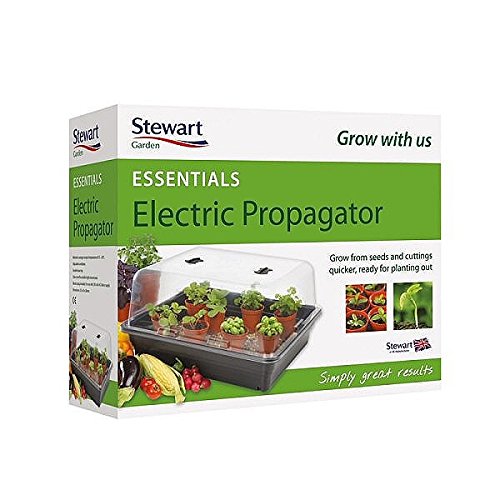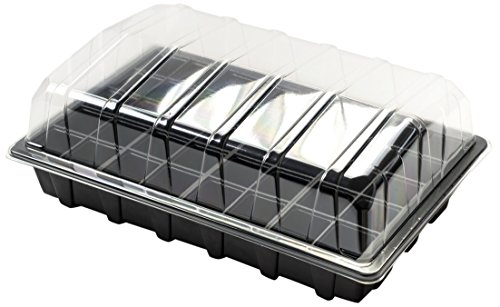Written by Terry Smith
Our site is reader supported so when you click a link to Amazon we may earn an affiliate commission.
UK’s best propagators for seeds: electric/non-electric and thermostat plant and cutting propagators for the greenhouse
This article was last updated on April 23rd, 2022 at 5:28 am
With the totally inconsistent and variable weather the UK keeps throwing at us (and I don’t just mean the cold – these current mild temperatures have me worried Spring will come late and the inevitable delayed cold). That means my seedlings (and potentially your cuttings) will be miles behind. Falling short of a mini greenhouse or grow tent and a greenhouse heater (you know one of those energy thirsty 2kW types). I have some handy tricks up my sleeve in this article with regards to fending off that costs and keeping the propagation in the conservatory (or in fact the greenhouse for a fraction of the cost if you prefer, and what is more, you’ll be able to enjoy watching them come on 🙂 with the assistance of the best propagator your money can buy in the UK – and they are not all that expensive either, not compared to the enjoyment factor of being a leg up on the competition 😀
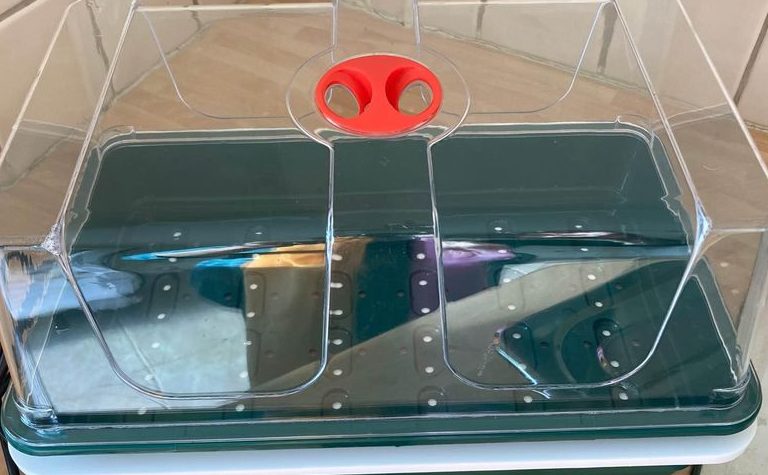
This is why so many of us Brit many gardeners choose to sow, and start off growing our seeds in a propagator, where we can manage the variables better and ultimately end up with healthy seedlings that can be moved into the garden, greenhouse, polytunnel (or wherever it may be) and transplant when the time is just right. Seeing something you planted as simple seeds grow into a marvellous looking plant, or even something you can pick and eat, is just so satisfying and using one of the best propagators is a great way to get started – it also keeps us well in touch with the garden through a dull Winter and something to occupy the cold.
In this article, we will look at the different types of propagators, their benefits, how to use them correctly, and also review the best propagator products that you can buy at this very moment. If that wasn’t enough, we’ve even added a best propagators buyer’s guide for good measure.
Best propagators for seeds and plants – Editors picks:
Best propagator overall: EarlyGrow 24″ x 15″ x 16.75″ Domed Propagator with 3 Height Extenders and Locking Clip Set
Best electric (heated) propagator: GARLAND BRITISH MADE BIG 3 ELECTRIC PROPAGATOR or the Stewart Essentials Electric Propagator on price
Best propagator with thermostat: GARLAND BRITISH MADE BIG 3 ELECTRIC PROPAGATOR
Best propagator for cuttings: Stewart Essentials Electric Propagator – lovely size with vents and thermostat so ideal to control humidity and not being too big means easier to control fungal outbreak. Ideal.
Best propagator for seeds: Garland GAL44LSW 24 Cell Self-Watering Propagator – must have for vulnerable seedlings that can’t dry out
Best propagator for indoors: Plant Theatre 3 Funky Propagator Pods must have for a conservatory setting. Just lovely – currently out of stock but i hope back soon as work in all homes with such a lovely design.
Best value: Nutley’s 40-Cell No Holes Seed Propagator Set (Pack of 3)
Professional pick: GARLAND BRITISH MADE BIG 3 ELECTRIC PROPAGATOR
Best Propagators Buyer’s Guide
To help you with your purchasing decision, here are a few things to roll over in your mind before buying your propagator. From size (some seedlings and cuttings need more depth), to style, multi level trays for space saving, large an small. Then you’ve got non electric and electric varieties with thermostats to consider as well. And then what about the vents? Don’t worry – let’s run through the options:
Size and depth
Think about what size of propagator would suit you best. They come in a wide range of sizes, but the vast majority of them are designed to sit snugly on your windowsill where they can catch the sunlight. Some models are larger though, and will need a good place to sit, especially if they are non-electric models and still need the warmth of the sun. As well as the general size of the propagator, the depth of the seed tray and the height of the lid are also very important – if you need depth it’s worth looking at the EarlyGrow . Some seedlings need more space in order for their roots to get properly established, and a shallow tray might stunt their growth. The same thing goes for plants that grow tall very quickly, and these will need a lid that gives enough room for proper growth.
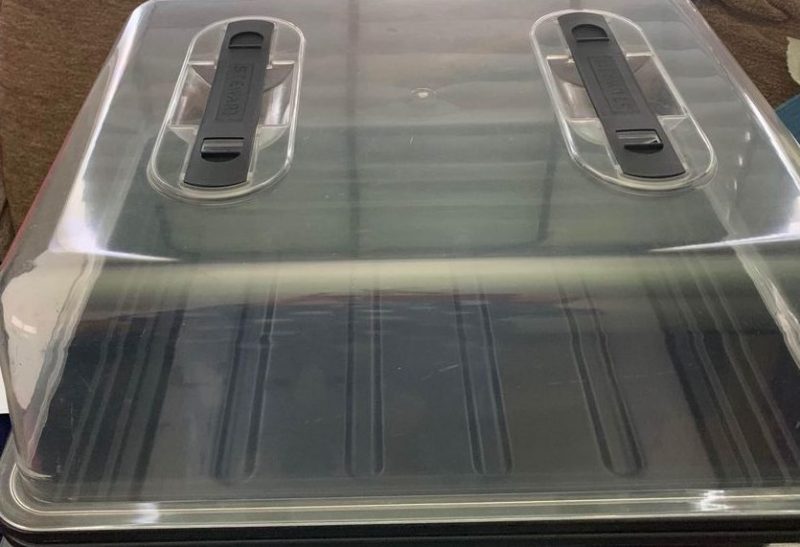
Ventilation
Not all propagators have air vents in them, and this is generally seen in the lower cost products – the higher prices ones like the EarlyGrow are vented beautifully, but obviously comes as cost. While it is not the end of the world to lift the lid to let some air circulate, having air vents certainly makes things easier, and if you’re a bit forgetful, they can be a life-saver (for your seedlings anyway) and is an important part of germinating your seeds as well as will help reduce rot and fungus – more about that in the how to ventilation section.
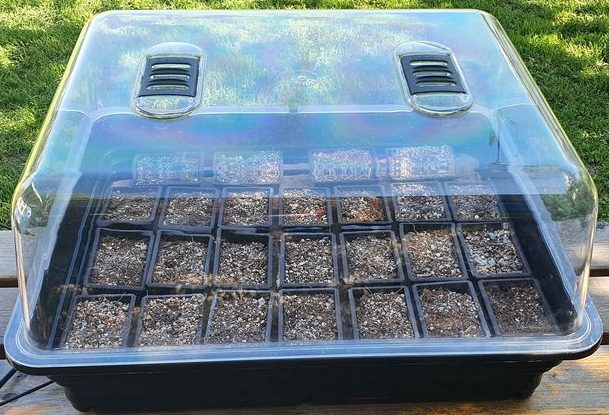
Thermostats
If you’re going to buy an electric propagator, I would suggest paying more for one with a thermostat like the Stewart or the GARLAND (best in my mind) that’ll make it easy for you to monitor the temperature inside the containers. If you’re on a tighter budget, one without a thermostat will do (Stewart Essentials Electric Propagator is super well priced just in case), but be sure to check with a thermometer every now and again. A good low-cost electric propagator will still help your seeds to grow quickly, even without a thermostat.
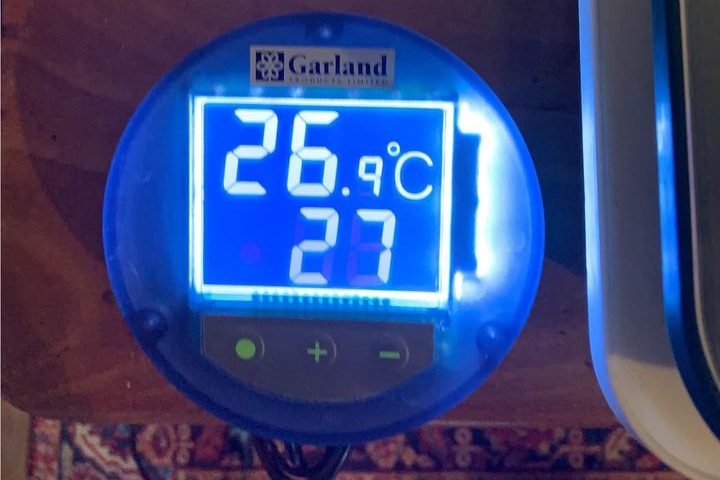
Electric vs non-electric propagators
The two main types of propagator that you will come across are electric and non-electric, also known as heated and non-heated. So, which should you go for? To be honest, they both do a good job of getting your seedlings going but I’d have to say that in my experience, a heated propagator does show results faster:

Of course, electric models tend to be more expensive than their non-powered counterparts both in the initial layout and the cost of running them. They can also dry the growing medium out faster, so you have to keep a closer eye on moisture levels. There are some types of seed that really need a constant temperature in order to thrive, and for these, an electric propagator is the right choice. For most though, a standard, non-electric model will work just fine.
Seedlings or cuttings
Following on from size – a somewhat cautionary note that seedlings and cuttings will thrive in different types of propagator. A seed propagator is normally much more shallow as it just doesn’t need the height pretty obviously so worth considering the top pick Garland GAL44LSW 24 Cell Self-Watering Propagator or the Nutley’s:
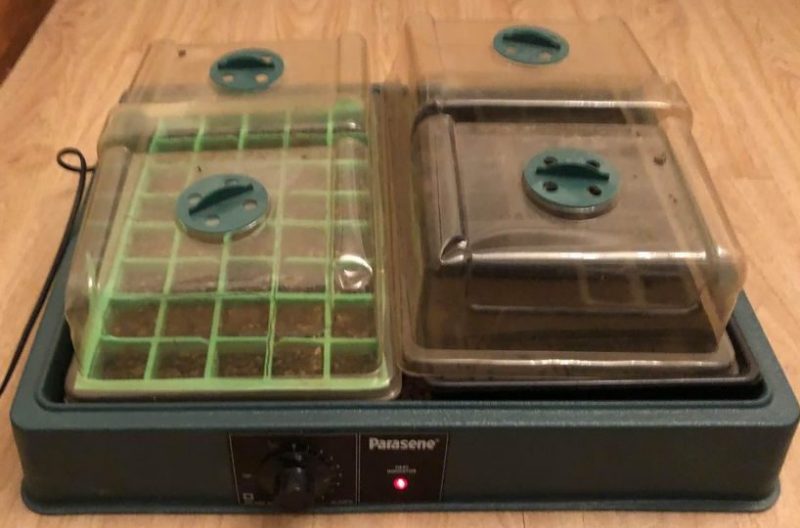
For cuttings I would definitely recommend the Stewart or the GARLAND and if you have a tall cutting the EarlyGrow isn’t a bad shout though not heated.
How to sow seeds in a propagator
One of the oldest tricks in the book is the good old fashioned bit of advice – read the bloody instructions 😀 No two seedlings want it exactly the same – depth, distance you sow apart and so on. So here’s a very generic look at sowing seeds – from here fine tune it with the few, but very important words on the back of that seed packet 🙂 and here’s a rundown from a nice chap on Youtube too – I’ve fast forwarded past the intro:
What soil to use?
First you need to prepare your seed tray, and that means using the right type of compost/soil. I generally make my own with a garden sieve and a mix of three to one compost to soil. There are plenty of products out there that are designed specifically to be used with seeds and cuttings, so get yourself the desired mix fill the tray with it. If going with cuttings I would want to make sure the soil is pretty clean – even if that means sterilising it – the number of times I’ve seen fungal growth in a humid propagator designed to bring on cuttings is to say the least, frequent!
Keep your soil fluffy
Once the tray is filled, you want to make it nice and level, but be careful not to compress the soil; it needs to remain light and fluffy for best results. Seedlings will break through and grow far less hindered – pretty obviously.
Check the depth of sowing and any other variables
With your seed tray ready, grab your seed packet and read the instructions. I know it sounds obvious, but so many people just sow seeds in their propagators without reading first and this can result in seeds being overcrowded, or not planted at the right depth and this just results in sub-par results.
Water gently
Time to add some moisture. You can either place your seed tray in a tray of water (water trough) (a little water, don’t overdo it), or water them very lightly from above with a watering can that has a fine spraying/mist rose .
Placement is important
Now all you need to do is to find a nice spot to sit your propagator on so that your seeds get some sunlight. Most people opt for a windowsill, or they place a small table near the window if the propagator is too large. Make sure you keep an eye on the moisture levels, and don’t just leave the propagator with the same side facing the window all the time, it needs to be rotated every now and again so that all the seeds get a fair share of the light.
Ventilation is important too
Don’t forget about ventilation. For the first couple of days, keep the air vents of your propagator closed, but when you see the first signs of them sprouting, you should open the vents to their half-way point to let some air flow through there. Too much humidity can cause them to rot (and in the case of cuttings, not enough and they won’t take). Later you can adjust the ventilation to suit your seedlings needs.
Best propagator reviews:
After reading this far, you should now be feeling a little more ‘in the know’ when it comes to propagators, and ready to buy your own. Now, you could just click on the first product you see online and hope for the best, or you could do the smart thing and read the section below. Here we have gotten our hands on some of the best rated propagators available and tried them out, to see if they are worth investing your time and money into.
1. EarlyGrow 24 x 15 x 16.75 Inch. Domed Propagator with 3 Height Extenders and Locking Clip Set,
Let’s kick off by addressing the elephant in the room, shall we? Yes, this is an expensive propagator considering it is not an electric model (the heated mats for Earlygrow are super by the way), but would I say it’s overpriced? I suppose I’d have to say no after comparing it to many other propagators that I’ve tried out over the years. So many times in the past, I’ve been frustrated by flimsy seed trays that bend with a bit of weight on them, badly fitting lids, air vents that don’t work properly or break easily, and god knows what else. With this product, there is none of that.
The EarlyGrow 95457 is a solid bit of kit. Made from thick, heavy duty, shatterproof plastic (polypropylene), you never feel like you have to handle it with kid gloves, and it gives you confidence to move it around even when filled with a lot of germinating trays or pots. I put it to the test by loading it up with a few larger pots from my greenhouse, and there wasn’t even the slightest sign of it becoming warped.
This plastic is non-toxic, and will not degrade under UV grow lights (so can be placed in a grow tent no problem) like some lower quality plastics can, so that should keep you organic growers out there happy. The modular design of this propagator means that you can extend the height of it by clipping on the extra sections that come in the box, up to a maximum height of 16.75 inches if measuring from the bottom of the soil tray, making it ideal for keeping larger seedlings inside until they can be planted outside – you don’t have to have this much height extension – here’s a look at a single tier that’s much cheaper:
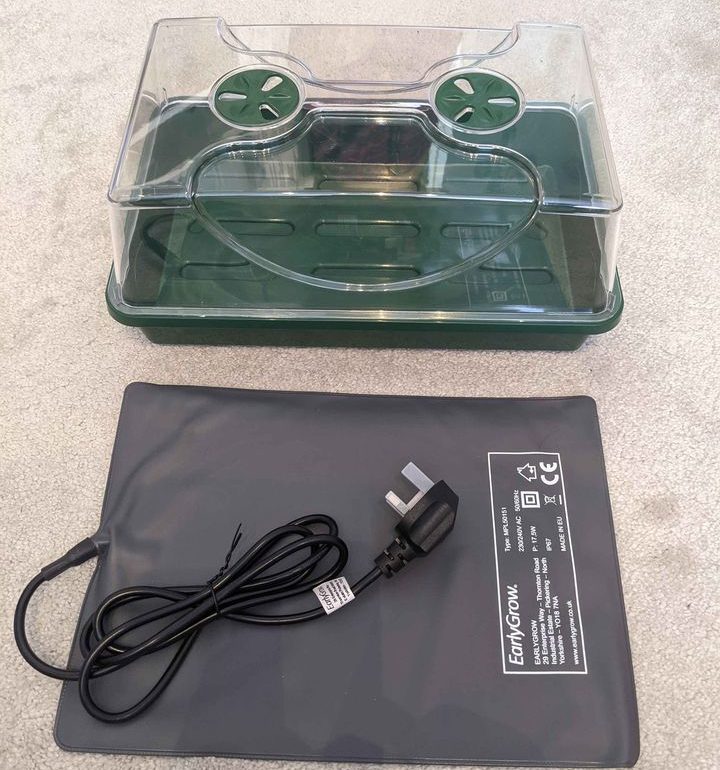
These sections all fit together perfectly, there’s no fiddling around, trying to get things to line up, and the small, plastic, locking clips really do a good job of holding the sections together. So much so, that it was easy for me to lift them all off at once as if they were a single unit. Each modular ‘wall’ section has two good-sized air vents in them, and the lid has another two, giving you a lot more control over humidity, air flow, and temperature than what you would normally get from a cheaper product.
When not needed, the side extension sections can be removed quickly and easily, and best of all; they can be broken down and stored out of the way until your seedlings start to grow a little more. I really liked this attention to detail, as it shows that Earlygrow have actually thought about how their decisions will affect the buyer’s experience.
The tray bed measures 24” x 15” and there’s enough room to get a fair old number of small germinating trays in there. With the extra height, and sturdy base, you also have the option of putting some larger and heavier pots in there too, which is a nice bonus. It might not be the cheapest option available, but I have to say the EarlyGrow 95457 is definitely one of the best propagators out there.
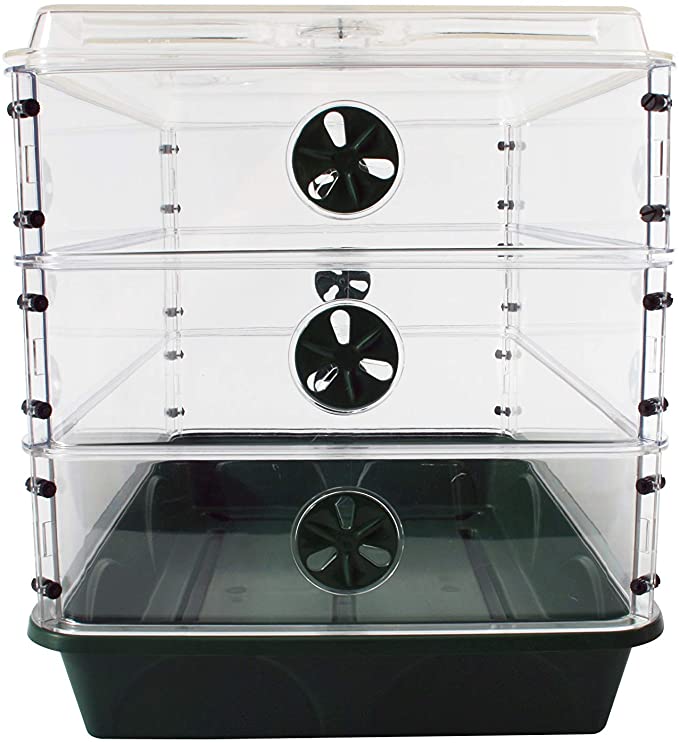
2. GARLAND BRITISH MADE BIG 3 ELECTRIC PROPAGATOR
Priced at just under 90 pounds, this large electric propagator is very fairly priced, in my opinion. With a main unit that can house three 37cm x 22cm propagator trays, this is quite a sizeable machine, and gives you the freedom to grow a wide range of plants and vegetables.
The three propagators are solidly built from good quality, injection moulded plastic, with shatter proof lids that are high enough to create lots of room for your botanical babies to grow into. The lids each have a circular air vent in the centre of the top, and these too are made from a durable plastic. They’re not indestructible of course, and for reasons that have to do with keeping the weight down to a minimum, none of these products are, but if I’m comparing them to your standard propagator, they’re built pretty well.
Designed to be economical when it comes to power usage, this British made electric propagator base will not be giving you nightmares about the electric bill, but can still keep a constant temperature of 19 degrees Celsius, thanks to the 50w heater and built-in thermostat.
To test the effectiveness of the Garland electric propagator, I set up a little test. I sowed some basil and parsley into the trays of this product, and also a similarly sized non-heated propagator to see if there was any difference in how the seeds reacted.
For the first few days there wasn’t any noticeable difference, and I thought I’d bought a dud, but then on about day four or five I noticed that there were far more sprouted seeds, and larger seedlings in the Garland propagator than the non-electric one. After a few more days, that trend only increased, so I would say that this product certainly does what it is supposed to.
The Garland electric propagator is a decent product for the price. It certainly speeds up the time it takes for your seeds to grow, from my tests anyway, and on top of that, it looks really good too.
The build quality, while nothing amazing, is better than a lot of products out there, and I personally don’ t have much to grumble about. I suppose an adjustable thermostat would have been nice, but then the price would be quite a bit higher, and put it in competition with higher end products. As it stands, it is a good mid-range electric propagator that gives you three good sized seed trays to play with, and keeps a steady temperature.
3. Stewart Essentials Electric Propagator
For those of you who are looking for a low-cost electric propagator to get your feet wet with, you could do a lot worse than this Stewart Essentials model, available for under 33 pounds on Amazon at the time of writing this article. I just love this model for cuttings – it’s got a thermostat, it’s tall enough, vents, and it doesn’t cost a fortune. Super buy rating and it’s a bonus it’s high quality too…
This is a good option for beginners, as it doesn’t have a thermostat or other controls that might be confusing. You just plug it in and you’re ready to go. With this being a budget model, you really can’t expect it to be creating micro-tropical conditions in there, so please be aware of that before you decide to buy. The 22-watt heater will add extra warmth, and this will help your seeds to grow faster, but the heat isn’t anything outstanding, and probably won’t be something that you are immediately aware of.
For something to keep a steady temperature that is a little higher than outside of the propagator, it is just fine, and the lower power means that you won’t be having a heart attack when the electric bill arrives, so that’s something to think about. In fact, it’ll only work out about two quid per month to run.
For the low price, I was expecting this to be fairly flimsy. However, I have to say the tray of this electric propagator is nice and solid and at 52cm x 42.5cm, it is a decent size for the money with plenty of space for a variety of pots inside.
The lid, on the other hand, isn’t quite up to the same standard, and you would have to be a bit careful with it so as not to damage it accidentally. The plastic is much thinner than on the base, but I suppose costs have to be cut somewhere to keep the price down. The lid has two adjustable air vents in the top, so you can control humidity and temperature. They’re an ok size for the unit, and feel a bit more durable than the lid itself.
So, to sum up. If you just want something that can constantly keep the internal temperature around 5 degrees warmer than outside, then this is a good buy. It will help you seeds to grow better in colder weather, at times like when you’re not at home and the heating is switched off. However, if you want an electric propagator that produces a lot of heat, and a temperature that you can control, you’re going to have to look elsewhere and spend a bit more money.
4. Garland GAL44LSW 24 Cell Self-Watering Propagator
New to the update is the Garland GAL44LSW 24 Cell Self-Watering Propagator. Since I last wrote the article I learned a trick or two (it’s been a couple of years after all). The easiest way to water your seedlings is from a self feeding tray. You ensure you don’t disturb them, it’s a never run out full proof way of ensuring your seeds germinate and turn to seedlings hassle free- and it comes with the added benefit of knowing that if you do need to pop out for a few days, all will be fine. The manufacturer says you can go 7 days – I’d be inclined not to push my luck but certainly four or five won’t hurt at all if topped up before you leave.
So for that reason this is my best pick for seed propagator in the UK.
Now it’s not heated so if you need a little oomph I’d recommend a heating mat. You can also place it by the windowsill given the size – it’s less than ten inches width so sits on most peoples window reveals internally pretty well.
It’s made from the same high quality plastic as all the other picks and pips the Nutley’s because it’s a complete kit – no need for separate water trays or troughs.
the only flaw is the size really – you can only germinate 24 seedlings at a time – the simple solution is to buy as many as you need though so hardly a drawback. One thing that is worth a mention though – you’ll need to be careful when transplanting. This is injection moulded blown plastic that’s pretty high quality. That means there’s not all that much flex to pop your seedling out come the time – worth a mention but certainly surmountable.
5. Nutley's 40-Cell No Holes Seed Propagator Set (Pack of 3)
A perfect propagator pack for people just starting out, this pack of three also offers the buyer excellent value for money. For just shy of ten pounds, you will get three units, each containing 40 cells, giving you the opportunity to kick start quite a few different varieties of seed in there.
At 38cm x 24cm, they are a decent size for the low price, and quite lightweight at only 540 grams. The cover stands quite high above the seed tray, so there’s enough room in there for your seedlings to grow into for a while before having to be transplanted.
Talking of trays, you might have been confused, like I was, by the ‘no holes’ phrasing in the product name and description, but in actual fact there are drainage holes in the inserts, but not in the bottom tray which catches any drips. The bottom tray is quite strong and sturdy for such a low cost propagator, but the inner trays are more flexible, which has its pros and cons. On the upside, it makes it easier to take seedlings out once they are growing, but on the other hand, it means that you have to be a bit careful handing them or you could cause damage.
As previously mentioned, the lid gives a good bit of space for the seedlings to grow into, but there is an absence of air vents. I suppose it is to be expected when you’re paying less than a tenner for three propagators of this size, but it does mean that you’ll have to remember to lift it up to let air circulate to prevent the humidity levels getting too high. Steamed vegetables are common in UK kitchens, but you should wait until they have fully grown before putting them through the process! The lid is also not that durable by the feel of it, and as I played around with it in my clumsy hands, I could definitely see myself breaking it after not too long. If you’re not quite the accident-prone one that I am, you should be ok though.
If you are going to buy these propagators, I would recommend buying some better-quality seed trays to fit inside. They are inexpensive and easy to find, and I think with that minor change, this product is definitely a good choice for beginners looking for a low-cost propagator to get started with.
6. Plant Theatre 3 Funky Propagator Pods
Getting your kids involved in gardening at a young age is extremely rewarding, not just for them, but also for you. Teaching them to care for another living thing develops a sense of responsibility, and it is an excellent activity to drag their attention away from those addictive smartphone screens.
Using a propagator to grow seedlings is an excellent way to start them off, and this particular product is a great match for young, budding gardeners.
For 17.99, you get three propagator pods that are all brightly coloured (red, green, and yellow), and each propagator pod can hold eight small (6cm diameter) pots inside in a circular pattern that resembles a flower and its petals. A good thing about this design is that it enables you to not only rotate the propagator around, but also the smaller, individual pots can themselves be rotated. This allows you to get sunlight to the plants that need it and is much easier to do so than with a conventionally shaped, box type propagator.
To stop your seed pots becoming waterlogged or flooded, there are run off channels for the excess H2O that are fairly deep and do their job very well. However, what don’t do their jobs quite so well, are the actual base trays of the propagators themselves. They’re just a little bit too flimsy to be moved around once you’ve got seeds growing in there, so this is a product best left in one spot.
In contrast to the base, the small pots that come with the propagator are good quality and will last for a long time, and the cover feels more substantial too. If only they’d have made the base a bit stronger, I would have had nothing to complain about.
Like I said, this is a good gift for kids or maybe a novelty thing for some people, but most adult gardeners would probably get annoyed at the fact that your pots wobble all over the place when you try to move the propagator pod to another spot. If you can put up with not lifting the thing though, it is a decent little product.
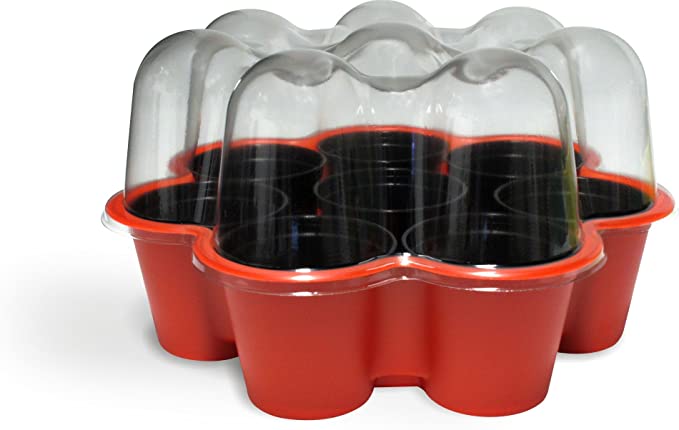
Is it worth buying a propagator?
A propagator might sound like some low-budget, knock off, sci-fi movie, but in actual fact, these simple devices are incredibly helpful if you’re trying to grow plants and vegetables from seeds or cuttings. You see, planting seeds directly into your garden soil can be problematic at times, as they are easily affected by changes in moisture, temperature, and also by other things such as being planted at the incorrect depth for that type of seed.
The main reason that people use propagators is to protect the seeds and seedlings when they are at their most vulnerable. With the UK’s climate being what it is, you never know what the temperature will be like from one moment to the next, and the same goes for the amount of rainfall too.
Another benefit of using one of these devices, is that they allow you to start growing earlier than what would be possible in your garden, giving you a head start on the growing season. In other words, no more twiddling your thumbs until spring arrives.






